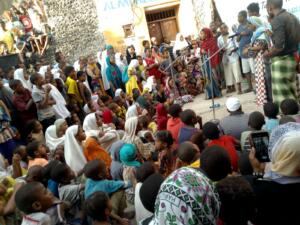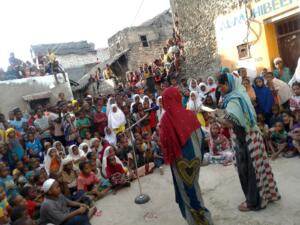HiMa Pate Phase Two – Project Update.
One year has passed since the launch of HIMA PATE project in Lamu, spearheaded by SAFE PWANI and LATA. The journey so far has been remarkable, and we’re thrilled to share the incredible progress they’ve made over the past year.
HiIMaA PATEate aims to harness the transformative power of arts to educate, inspire and empower communities on Pate Island to take action to build their resilience to climate change, protect their natural environment and thrive.
Overview of Activities
In the second phase of HiMa Pate, SAFE and LATA introduced two strategies to further their objectives:
Community Performance Tour:
A performance skit was created on the theme of environmental conservation, and toured across Pate Island. The skit served as a powerful medium to remind the community of their environmental heritage and drew parallels with the present situation. The performance served to vividly illustrateing the potential future consequences of inaction on current environmental issues, and challenged the community to reflect and take necessary measures. They successfully coordinated performances in multiple venues, including Mtangawanda, Shanga Rubu, Shanga Ishakani, Siyu, and Pate on December 16th to 22nd. These community performance days were a significant milestone.
Environmental Workshops:
As a follow-up to the community outreach tour, the groups conducted environmental workshops. During these workshops, the team capitaliszed on the solutions and ideas that emerged from the post-performance dialogues. They worked closely with key community stakeholders to develop these solutions into actionable plans. The workshop methodology included brainstorming sessions, interactive question and answer sessions, focused group discussions, and the use of visual aids, such as drawings, to convey climate change concepts. Leading the workshops were David Kalume, SAFE Pwani Team Leader, Khadija Rajab, Project Officer, and Said Ali, LATA’s Executive Director.
These initiatives in the second phase of HiMa Pate have enhanced community engagement and provided a platform for dialogue, reflection, and collaborative action. By leveraging the power of storytelling and participatory workshops, SAFE and LATA aims to inspire positive change and drive environmental conservation efforts on Pate Island.

Challenges in Implementation:
Despite the success of this phase the groups did face some challenges that they were able to overcome.
Unforeseen Weather Changes: The project faced challenges due to unpredictable weather conditions, particularly heavy rains. This resulted in a delayed start for the Mtangawanda show and the need to reschedule the PATE Community show.
Venue Limitations in Siyu: The community and school shows in Siyu had to be relocated from the social hall to the village community ground and the Siyu fort, respectively. This adjustment was necessary due to limited access to schools during the period when national examinations were taking place.
Shifting Community Engagement Dynamics: One of the challenges encountered was the community’s unfamiliarity with direct engagement in developing solutions to the issues they face. In the past, they were accustomed to government agencies, private entities, and social sector partners prescribing solutions while receiving personal emoluments and funding. However, The HiMa Pate project takes a different approach by empowering community members to take the lead in implementing the agreed action plans. SAFE PWANI and LATA, in this context, play a supportive role rather than dictating the solutions.
Despite these challenges, the project persevered and adapted to ensure the successful continuation of its activities. By addressing unforeseen circumstances and shifting engagement dynamics, the project remains committed to its goal of empowering the community and fostering environmental resilience on Pate Island.

Review of Outcomes
The activities implemented in the second phase of HIMA PATE have brought the project closer to its objectives . in a number of ways. Through During the community performance tour, storytelling was used to educate and empower Pate Island communities, highlighting the need for action to address climate change and protect the environment.
These performances instilled a sense of urgency and responsibility within the community, helping them to build resilience. Additionally, the environmental workshops facilitated active participation of key stakeholders, empower the community to develop actionable plans and take the lead in implementing solutions further building their resilience and creating strong environmental actors in the communities reached. This participatory approach has fostered a culture of environmental stewardship, creating lasting impact and a sustainable future for Pate Island.
Conclusion
The HiMa Pate project is making significant progress towards its objectives and there’s still one phase to go which the team are working on now.
The next steps involve building upon the achievements of the second phase, continuing to engage and empower the Pate Island communities, and implementing the action plans developed during the environmental workshops.
With each passing day, the positive impact of HiMa Pate becomes more evident. The project has not only raised awareness and inspired action but has also fostered a sense of collective responsibility among the community members. It is heartening to witness the growing commitment and enthusiasm towards environmental conservation on Pate Island. Together, we are creating a legacy of sustainable practices and nurturing a vibrant future for generations to come.
